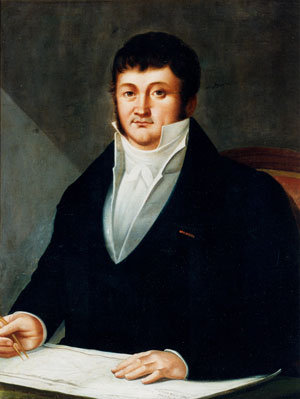
Robert Surcouf was a French privateer, businessman and slave trader who operated in the Indian Ocean from 1789 to 1808 during the French Revolutionary and Napoleonic Wars. Capturing over 40 prizes, he later amassed a large fortune from a variety of commercial activities, such as ship-owning, privateering, slave trading and owning land.

Count Toussaint-Guillaume Picquet de la Motte, also known as La Motte-Picquet was a French Navy officer and admiral. Over a career spanning 50 years, he served under Louis XV and Louis XVI and took part in 34 campaigns. He fought in the Seven Years' War and in the Naval battles of the American Revolutionary War, earning the ranks of Commandeur in the Order of Saint Louis in 1780, and of Grand Cross in 1784. He died during the French Revolution.

Jean-Marthe-Adrien L'Hermite was a French sea captain and rear admiral, notable for his involvement in the Glorious First of June and his expedition into the Atlantic in 1805.

Count Honoré Joseph Antoine Ganteaume was a French Navy officer and Vice-admiral.

Jean-Baptiste Philibert Willaumez was a French naval officer and nobleman who served during the French Revolutionary Wars and Napoleonic Wars. Willaumez joined the French Navy at the age of 14, and proved to be a competent sailor. Having risen to the rank of pilot, he started studying navigation, attracting the attention of his superiors up to Louis XVI himself. Willaumez eventually became an officer and served under Antoine Bruni d'Entrecasteaux in his expedition to rescue Jean-François de Galaup, comte de Lapérouse and explore the Indian Ocean and Oceania.

Surveillante was an Iphigénie-class 32-gun frigate of the French Navy. She took part in the Naval operations in the American Revolutionary War, where she became famous for her battle with HMS Quebec; in 1783, she brought the news that the war was over to America. She later took part in the French Revolutionary Wars, and was eventually scuttled during the Expédition d'Irlande after sustaining severe damage in a storm. The wreck was found in 1979 and is now a memorial.

Pierre-François-Henri-Étienne Bouvet de Maisonneuve was a French Navy officer and privateer.

Cybèle was a Nymphe-class 40-gun frigate of the French Navy.
Harmonie was a 40-gun Virginie-class frigate of the French Navy. Her crew scuttled her on 17 March 1797 to avoid having the Royal Navy capture her. She on being burned was reported as pierced for 44 guns

The action of 28 June 1803 marked the opening shots of the Blockade of Saint-Domingue after the collapse of the Treaty of Amiens and the outbreak of the War of the Third Coalition in May 1803.
Andromaque was a 32-gun Nymphe-class frigate of the French Navy.
Amand Leduc was a French sailor and Navy officer of the First French Empire.
The action of 18 June 1799 was a naval engagement of the French Revolutionary Wars fought off Toulon in the wake of the Mediterranean campaign of 1798. A frigate squadron under Rear-admiral Perrée, returning to Toulon from Syria, met a 30-ship British fleet under Lord Keith. Three ships of the line and two frigates detached from the British squadron, and a 28-hour running battle ensued. When the British ships overhauled them, the French frigates and brigs had no choice but to surrender, given their opponents' overwhelming strength.
Théobald-René, Comte de Kergariou-Locmaria was a French Navy officer and Royalist émigré.

Saint Louis was a French East Indiaman, launched on 27 July 1752. She served in the Indian Ocean where she participated in three battles and at least one single-ship action. In 1768, she became a careening hulk in Lorient.
HMS Fortune was a British 14-gun sloop launched in 1778 that the French captured in April 1780. She then served with the French navy under the same name.
Dauphine was a small 4-gun corvette of the French Navy. She is notable for the rescue operation to Tromelin Island that gave it its present name, and for taking part in the Second voyage of Kerguelen. The Baie de la Dauphine, in the Kerguelen Archipelago, is named in her honour.

Amazone was a 32-gun Iphigénie-class frigate of the French Navy. She was the second ship of the French Navy to receive a copper sheathing in 1778. She served in the War of American Independence under Captain Lapérouse, and later in the French Revolutionary Wars.
Naïade was a 20-gun Coquette-class corvette. She took part in the Indian theatre of the Anglo-French War with the squadron under Suffren. The British Royal Navy captured her in 1783 but never commissioned her; it sold her in 1784.
Gros Ventre was an armed storeship of the French Navy. She is notable for taking part in the First voyage of Kerguelen and for her subsequent solo mission of discovery to Australia. Anse du Gros Ventre was named in her honour.










